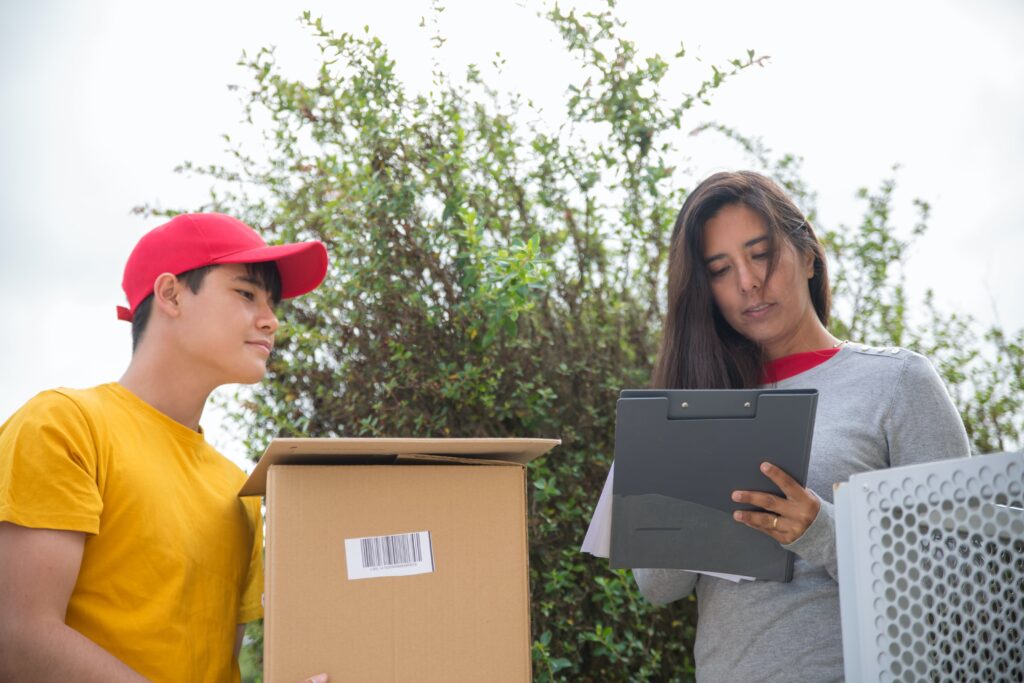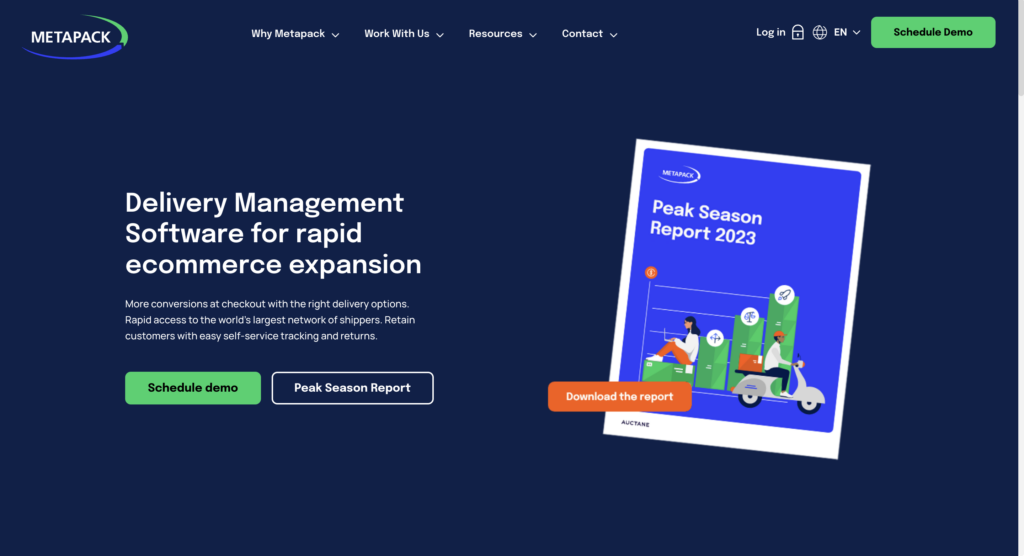 Sign up
Sign up .png)
 (2).png)
How to Optimize E-commerce Shipping for Customer Satisfaction
Ah, the thrill of online shopping! That dopamine hit when you click ‘buy now’, the anticipation as you await your package, and the joy of unboxing. But behind this simple consumer journey lies a complex web of logistics, decisions, and challenges. Shipping isn’t just about moving products; it’s about delivering promises, building trust, and ensuring that the digital shopping experience translates into tangible satisfaction. Dive in with us as we navigate the intricate waters of e-commerce shipping, exploring its significance, the challenges of international deliveries, and the role of technology in ensuring that every package is a parcel of joy.
Content
 The Significance of Shipping in E-commerce
The Significance of Shipping in E-commerce Navigating the Complexities of International Deliveries
Navigating the Complexities of International Deliveries Competitive Shipping Rates Without Compromising Profits
Competitive Shipping Rates Without Compromising Profits Crafting an Efficient and Fair Return Process
Crafting an Efficient and Fair Return Process Leveraging Technology for Seamless Shipping Management
Leveraging Technology for Seamless Shipping Management
The Significance of Shipping in E-commerce
In the bustling world of e-commerce, it’s easy to get caught up in the whirlwind of product listings, marketing campaigns, and customer reviews. However, there’s one aspect that often gets overshadowed, yet holds paramount importance: shipping. It’s not just about delivering a product; it’s about delivering an experience.
Delivering Beyond Products
Imagine this: you’ve spent hours, maybe even days, meticulously selecting the perfect item online. The anticipation builds as you wait for it to arrive. But then, it’s late. Or worse, it’s damaged. That initial excitement quickly turns to frustration. This is a scenario far too many online shoppers can relate to. Efficient shipping isn’t just a logistical concern; it’s a cornerstone of customer satisfaction. When businesses nail their shipping strategy, they’re not just delivering products; they’re delivering trust, reliability, and a reason for customers to return. In essence, every successful delivery strengthens the bond between brand and buyer, fostering loyalty that transcends a single transaction.
The Amazon Effect
Enter Amazon, the e-commerce behemoth that has, for better or worse, recalibrated our delivery expectations. With promises of Prime deliveries reaching doorsteps in a day (sometimes even hours!), the bar has been set astronomically high. This phenomenon, often dubbed the ‘Amazon Effect’, has reshaped the e-commerce landscape. Customers now expect faster, more reliable shipping from all online retailers, not just the giants. It’s a challenging benchmark, especially for smaller businesses. But it’s also an opportunity. By understanding and adapting to these heightened expectations, businesses can position themselves as customer-centric brands ready to meet the demands of modern e-commerce. After all, in today’s digital age, shipping speed and reliability aren’t just luxuries; they’re necessities.

In the wake of Amazon’s trailblazing, it’s clear that shipping is more than a mere afterthought. It’s a pivotal part of the e-commerce journey, influencing perceptions, trust, and ultimately, the decision to hit that ‘buy again’ button. So, as we hop on this high-octane ride through the world of e-commerce shipping, let’s delve deeper into how businesses can navigate this crucial terrain, ensuring every package delivered is a promise kept.
Navigating the Complexities of International Deliveries
The allure of e-commerce lies in its boundless nature. A store in London can effortlessly serve a customer in Tokyo, bridging thousands of miles with a single click. But with this global reach comes a unique set of challenges, especially when it comes to shipping. International deliveries are a different beast altogether, demanding a blend of meticulous planning, cultural understanding, and a dash of adaptability.
Crossing Borders with Care
Every country, with its unique set of rules, regulations, and customs protocols, is like a new puzzle for e-commerce businesses to solve. Navigating the labyrinth of customs documentation, understanding the intricacies of duties and taxes, and meeting varying delivery standards can be daunting. A package that breezes through customs in one country might face delays in another due to a minor oversight. And these hiccups aren’t just logistical headaches; they directly impact the customer’s experience. A delay due to customs can quickly turn an excited customer’s anticipation into disappointment, potentially jeopardising future sales.
Moreover, there’s the added layer of ensuring products meet the regulatory standards of the destination country. What’s acceptable in one nation might be prohibited in another. It’s a tightrope walk, demanding businesses to be constantly updated, ensuring every package sent across borders is compliant, and primed for a smooth journey.
Global Shipping, Localised Approach.
But here’s the silver lining: with challenge comes opportunity. The key to seamless international shipping lies in adopting a localised approach. It’s about understanding that while e-commerce breaks geographical barriers, cultural and logistical nuances still hold sway.
Choosing the right carrier is the first step. Collaborating with carriers renowned for their international expertise can make a world of difference. They bring to the table a deep understanding of regional customs protocols, ensuring packages aren’t just dispatched but delivered, without hitches.
But it doesn’t stop there. Successful international shipping is also about understanding regional preferences. For instance, while doorstep delivery might be the norm in the UK, customers in Japan might prefer picking up their packages from designated collection points. Tailoring delivery options to suit these local preferences can significantly enhance customer satisfaction.
Moreover, clear communication is crucial. Keeping customers informed about potential customs duties, providing accurate delivery timelines, and offering tracking options can set the right expectations, reducing the chances of post-purchase dissonance.
In essence, while the world of international shipping might seem like uncharted waters, with the right strategies, it’s a voyage every e-commerce business can confidently embark on. After all, in the age of globalisation, the world isn’t just a marketplace; it’s an opportunity waiting to be seized. So, as we continue our journey, let’s delve into how businesses can further optimise their shipping strategies, ensuring every package, whether local or international, is a testament to their brand’s promise.
Competitive Shipping Rates Without Compromising Profits
In the bustling world of e-commerce, where customers are spoilt for choice, shipping rates can be the tipping point between an abandoned cart and a successful sale. But here’s the catch: while customers love free or low-cost shipping, businesses have to grapple with the challenge of offering competitive rates without eroding their profits. It’s a delicate balance, one that demands innovation, strategy, and a keen understanding of the market.
The Free Shipping Conundrum: A Double-Edged Sword
Free shipping, in many ways, has become the golden standard in e-commerce. Giants like Amazon have set the bar high, with their Prime memberships offering speedy, free deliveries. But for smaller businesses, offering free shipping can be a costly affair. While it’s a powerful incentive that can boost sales and customer loyalty, it can also eat into profit margins if not implemented strategically.
Take the case of Zappos, for instance. The online shoe retailer made waves in the industry with its free shipping and 365-day return policy. While this approach significantly boosted their customer loyalty and brand image, it was also a calculated move. Zappos understood that the lifetime value of a loyal customer far outweighed the immediate costs of free shipping. They banked on repeat purchases and word-of-mouth marketing, turning what seemed like a cost-heavy strategy into a long-term investment.
Hybrid Delivery Models: Striking the Right Balance
So, how can businesses, especially those without the deep pockets of industry giants, offer competitive shipping rates? The answer lies in hybrid delivery models. Instead of a one-size-fits-all approach, businesses can offer a mix of free, flat-rate, and real-time carrier-calculated shipping.
For instance, businesses can offer free shipping for orders above a certain value, encouraging customers to buy more. Alternatively, they can provide free shipping as a limited-time promotional offer, creating urgency and driving sales. Flat-rate shipping, where customers pay a standard rate regardless of the package size or weight, can be another effective strategy, simplifying the decision-making process for customers.
Moreover, integrating real-time carrier-calculated shipping at the checkout can provide customers with a range of options, from standard to expedited delivery, allowing them to choose based on urgency and willingness to pay.

In essence, while competitive shipping rates are a potent tool in the e-commerce arsenal, they need to be wielded with care. By adopting a flexible, hybrid approach, businesses can cater to customer expectations without compromising on their bottom line. As we journey further, we’ll explore more strategies to ensure that every aspect of your e-commerce shipping is optimised for success, from managing returns to ensuring timely deliveries.
Crafting an Efficient and Fair Return Process
In the digital age, where customers can’t physically touch or try products before purchasing, returns are an inevitable part of the e-commerce journey. However, returns aren’t just a logistical challenge; they’re a golden opportunity to build trust, enhance brand loyalty, and create a seamless shopping experience. Let’s dive into the world of returns, understanding their significance and how businesses can strike the right balance.
Trust Through Returns: More Than Just a Policy
Imagine this: You’ve just bought a stylish pair of shoes online, but when they arrive, they’re a tad too tight. Now, if returning them is a hassle, filled with unclear policies and tedious processes, you’re less likely to shop from that store again. On the flip side, a smooth, hassle-free return process can turn a potentially negative experience into a positive one, fostering trust and encouraging repeat purchases.
A transparent and fair return policy isn’t just a logistical necessity; it’s a statement of a brand’s commitment to customer satisfaction. It tells your customers, “We’ve got your back, even if things don’t go as planned.” It’s this assurance that can set a brand apart in the crowded e-commerce landscape, turning one-time shoppers into loyal brand advocates.
Balancing Customer Needs and Logistics: A Win-Win Approach
Crafting a return process that’s both customer-friendly and logistically feasible can seem like walking a tightrope. However, with a bit of innovation and strategy, businesses can create solutions that cater to both ends of the spectrum.
- Hassle-Free Return Labels: Companies like ASOS have set a benchmark by offering pre-paid return labels with every purchase. This not only simplifies the return process for customers but also allows businesses to negotiate bulk shipping rates, reducing logistical costs.
- Centralised Return Centres: Brands such as Amazon have centralised return centres, where customers can drop off their returns. This streamlines the return process, reduces shipping costs, and speeds up the refund or exchange process.
- Try Before You Buy: A more recent innovation in the e-commerce space is the ‘try before you buy’ model. Platforms like Klarna allow customers to order products, try them out, and only pay for what they keep. While this might increase the volume of returns, it significantly boosts sales, as customers are more willing to purchase when the risk of dissatisfaction is minimised.
- Clear Communication: Often, returns can be reduced by simply providing clearer product information. Detailed size guides, 360-degree product views, and customer reviews can help shoppers make more informed decisions, reducing the likelihood of returns.
In the grand scheme of e-commerce, returns are more than just a logistical challenge; they’re a touchpoint, an interaction, a chance to reaffirm a brand’s commitment to its customers. By balancing customer needs with logistical realities, businesses can craft a return process that’s efficient, fair, and a testament to their dedication to customer satisfaction. As we gear up to explore the final leg of our e-commerce journey, let’s remember that every challenge, be it shipping or returns, is an opportunity in disguise, waiting to be harnessed.
Leveraging Technology for Seamless Shipping Management
In the fast-paced world of e-commerce, where customer expectations are sky-high, and the competition is just a click away, businesses can’t afford to drop the ball when it comes to shipping. But fear not! The digital age isn’t just about challenges; it’s packed with solutions. From cutting-edge software to the power of artificial intelligence, let’s explore how technology is revolutionising the shipping game.
Digital Solutions for Physical Deliveries: The Modern Courier's Toolkit
Shipping, at its core, is a physical process. Products move from warehouses to doorsteps, crossing cities, countries, and sometimes even continents. But behind this tangible journey lies a world of digital solutions, streamlining operations and enhancing customer experiences.
- Advanced Shipping Manager: A favourite among UK Shopify e-commerce businesses, this tool offers real-time shipping rates, bulk label printing, and even dropshipping management. It’s an all-in-one solution, catering to businesses of all sizes.
- Metapack: Born and bred in the UK, Metapack offers a range of delivery management solutions. From carrier management to tracking and returns, it’s a comprehensive platform for businesses looking to optimise their shipping operations.

- ShipStation: With integrations with popular e-commerce platforms like WooCommerce and Magento, ShipStation simplifies order processing, label printing, and customer communication, making shipping a breeze.
- Veeqo: Tailored for the UK market, Veeqo streamlines multi-channel shipping, offering features like inventory management and wholesale order processing. It’s a holistic solution for businesses looking to scale their operations without the logistical headaches.
Predictive Shipping with AI: The Future is Here
Imagine a world where you could predict shipping challenges before they arise. A world where you could offer solutions in real-time, ensuring customer satisfaction and operational efficiency. Sounds like science fiction? Well, with the power of AI, this future is already here.
Artificial intelligence, with its ability to analyse vast amounts of data and identify patterns, is revolutionising shipping management. By analysing historical shipping data, weather patterns, and even social media chatter, AI can predict challenges like delivery delays or damaged goods. For instance, if a snowstorm is predicted in a particular region, AI can reroute deliveries, ensuring timely arrivals. Or if a particular product has a history of being damaged during shipping, AI can suggest alternative packaging solutions.
Brands like UPS and FedEx are already leveraging AI to optimise their operations, offering real-time solutions to age-old shipping challenges. It’s not just about problem-solving; it’s about proactive management, ensuring that challenges are addressed before they even arise.
In the world of e-commerce, where every delivery is a touchpoint, an interaction, a chance to impress, leveraging technology is no longer optional. It’s a necessity, a tool to ensure that businesses can meet, and exceed, the ever-evolving expectations of their customers. As we wrap up our deep dive into e-commerce shipping, let’s remember that in the digital age, challenges are just opportunities in disguise. And with the right tools, the sky’s the limit.
Final Thoughts
In the vast digital marketplace, where customers are spoilt for choice and competition is fierce, shipping emerges not just as a logistical necessity but as a strategic tool. It’s a reflection of a brand’s commitment, its dedication to customer satisfaction, and its adaptability in the face of challenges. From understanding the ever-evolving regulations to leveraging technology for seamless operations, e-commerce shipping is a journey, a continuous process of learning, adapting, and delivering.
For businesses, it’s a reminder that behind every click is a customer, a person awaiting their package, their slice of joy. And for customers, it’s a testament to the lengths brands will go to ensure their satisfaction. As we sail into the future of e-commerce, one thing is clear: shipping will continue to play a pivotal role, and those who master its nuances will lead the way. Curious about how to further optimise your e-commerce operations? Dive deeper with Anomate and embark on a journey towards unparalleled e-commerce success.
You are one click away from transforming
your ecomm biz.


 2.png)
